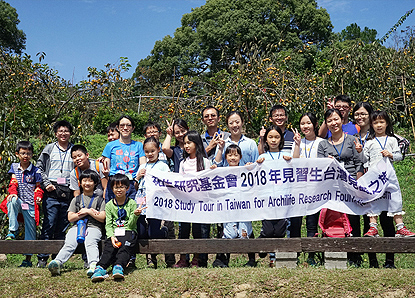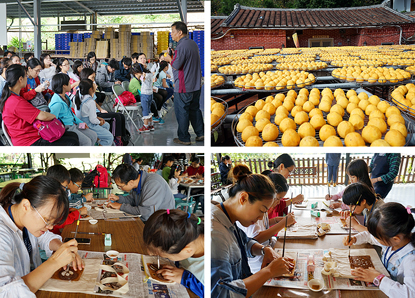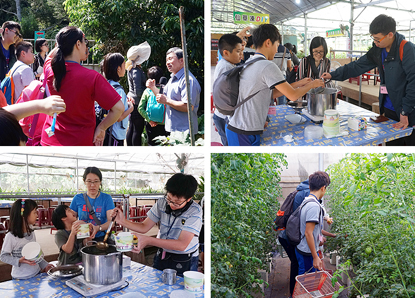Sketch of Archilife Study Tour, October 2018
|
2018年10月份見識之旅縮影  10月份見識之旅活動,於2018年10月20日由呂明澐小姐帶領20位祐生見習生及家長們,進行新埔金黃柿餅聞香趣暨關西仙草手做體驗之旅。活動開始之初,領隊呂明澐小姐提醒本次活動注意事項及觀察重點,先行建立見習生的背景知識。 10月份見識之旅活動,於2018年10月20日由呂明澐小姐帶領20位祐生見習生及家長們,進行新埔金黃柿餅聞香趣暨關西仙草手做體驗之旅。活動開始之初,領隊呂明澐小姐提醒本次活動注意事項及觀察重點,先行建立見習生的背景知識。For the study tour of October 20, 2018, Ms. Lu Ming-yun led 20 ARF interns and their parents on a tour to learn about dried persimmon in Xinpu and experience making grass jelly in Guanxi. At the start of the day's activities, team leader Ms. Lu Ming-yun reminded everyone about things to note and what to observe, and gave the interns some background knowledge.  本次上午行程參訪金漢柿餅教育農園,由農園主人擔任導覽老師。行程一開始,導覽老師介紹柿子的種類特徵與生長環境,解釋同一顆柿子樹的果實,會因授粉與否導致形狀差異,底部較尖者為有授粉,底部較圓者則否。隨後導覽老師請眾人品嚐一小塊澀柿,透過味覺體驗「澀」帶來的感覺衝擊,說明澀柿含有可溶性單寧酸,會產生澀味,直接單吃會造成口腔乾燥與縮皺的不適感,唯一有效解澀方法是「甜」。接著眾人吃下柿餅,感受口中澀味頓時消除,驗證甜與澀為互補。導覽老師以方才之經驗,講述平地澀柿須經脫澀才能食用,並介紹三種脫澀的方式,即削皮後風乾成柿餅、泡水做脆柿、與蘋果放置於同一處催熟脫澀成軟柿。其中特別強調,柿餅上的白色粉末為柿子內含的糖分滲出後,結晶凝結的柿霜,絕非發霉,有止咳潤肺的功效。 本次上午行程參訪金漢柿餅教育農園,由農園主人擔任導覽老師。行程一開始,導覽老師介紹柿子的種類特徵與生長環境,解釋同一顆柿子樹的果實,會因授粉與否導致形狀差異,底部較尖者為有授粉,底部較圓者則否。隨後導覽老師請眾人品嚐一小塊澀柿,透過味覺體驗「澀」帶來的感覺衝擊,說明澀柿含有可溶性單寧酸,會產生澀味,直接單吃會造成口腔乾燥與縮皺的不適感,唯一有效解澀方法是「甜」。接著眾人吃下柿餅,感受口中澀味頓時消除,驗證甜與澀為互補。導覽老師以方才之經驗,講述平地澀柿須經脫澀才能食用,並介紹三種脫澀的方式,即削皮後風乾成柿餅、泡水做脆柿、與蘋果放置於同一處催熟脫澀成軟柿。其中特別強調,柿餅上的白色粉末為柿子內含的糖分滲出後,結晶凝結的柿霜,絕非發霉,有止咳潤肺的功效。The morning's itinerary brought everyone to Jinhan Dried Persimmon Education Farm where the farm owner was the tour guide. The tour began with the introduction to the different types of persimmon and their characteristics and growth environment. The tour guide explained that fruits of the same persimmon tree will vary in shape depending on whether they are pollinated. Those with a more pointed bottom are pollinated while those with a rounder bottom are not pollinated. He then invited everyone to try a small piece of astringent persimmon to experience the sensory impact of the "astringent" taste. He explained that astringent persimmon contains soluble tannic acid which causes the astringent taste. Eating it directly will cause mouth dryness and puckering. The only way to get rid of the astringent taste is "sweetness". Once everyone took a bite of dried persimmon, the astringent taste immediately disappeared, proving that sweetness and astringent bitterness complement each other. Using the experience, the tour guide explained that astringent persimmons growing at low altitude can only be eaten after the astringent taste is removed. There are three ways to remove the astringent taste, i.e. peel off the skin and dry out the fruit, soaking the fruit to make crispy persimmon, and placing it together with apple to ripen and soften it. He particularly emphasized that the white powder on the dried persimmon is crystallized sugar that comes from within the persimmon. It is not mold and has the restorative effect of stopping cough and lubricating the lungs.  中午飯後,前往關西仙草博物館生態農場,由農場主人擔任導覽老師。導覽老師首先帶領眾人認識園區果樹,特別指出容易被忽略的仙草植株,講述仙草的命名由來及功效。透過展示熟成的仙草乾,說明仙草自植株到可食用的仙草凍,須先以鋤頭連根掘起的方式採收,於田間曝曬風乾後,放入倉庫約一年待其熟成,再清洗熬煮成汁,加入澱粉才能製做成凍。行程最後,至金勇番茄農場參觀。導覽人員解說園區內種植的30餘種番茄,多由國外引進,在台灣不常見,並比較不同品種間的形狀顏色及營養價值。最後進行番茄採果體驗,藉由採摘過程,實際觀察各品種的特徵,認識日常食用蔬果的延伸知識。至此,本日活動已近尾聲,大家一起合照留念後搭車返程,並期待於下次見識之旅再相見。 中午飯後,前往關西仙草博物館生態農場,由農場主人擔任導覽老師。導覽老師首先帶領眾人認識園區果樹,特別指出容易被忽略的仙草植株,講述仙草的命名由來及功效。透過展示熟成的仙草乾,說明仙草自植株到可食用的仙草凍,須先以鋤頭連根掘起的方式採收,於田間曝曬風乾後,放入倉庫約一年待其熟成,再清洗熬煮成汁,加入澱粉才能製做成凍。行程最後,至金勇番茄農場參觀。導覽人員解說園區內種植的30餘種番茄,多由國外引進,在台灣不常見,並比較不同品種間的形狀顏色及營養價值。最後進行番茄採果體驗,藉由採摘過程,實際觀察各品種的特徵,認識日常食用蔬果的延伸知識。至此,本日活動已近尾聲,大家一起合照留念後搭車返程,並期待於下次見識之旅再相見。After lunch, the tour group made its way to Guanxi Mesona Museum's ecological farm. The farm owner, who acted as the tour guide, began the tour by bringing everyone to learn about fruit trees, particularly pointing out the easy-to-miss mesona. He talked about the origin of the mesona's name, and its restorative effect. While showing everyone what the dried mesona looked like, he explained that the plant has to be harvested by uprooting the plant using a hoe, wind dried in the field and placed in the warehouse for about a year. To make into jelly form, it has to be washed and boiled, and starch has to be added to the strained liquid. The final part of the study tour was a trip to Chin-Yong DIY Recreation Farm where over 30 species of tomatoes are grown. The tour guide explained that the species are mostly imported from overseas and are uncommon in Taiwan. She also compared the differences in their shape, color and nutritional value. Everyone tried their hands at harvesting tomatoes and learned to observe their different characteristics, expanding their knowledge of everyday fruits and vegetables. At this point, the day's itinerary came to an end. Everyone took a group photo before heading back and looked forward to the next study tour. |

